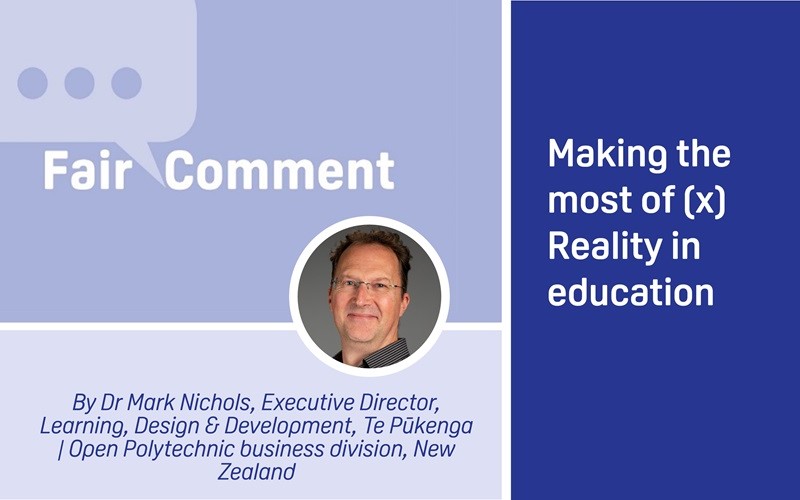
The technology is there, and education is eager to apply it. But how do we apply augmented/virtual/mixed reality in ways that will make a positive difference to learning?1 Let’s start by defining just what it is we are dealing with here. Augmented, virtual and mixed reality are different. Augmented describes digital objects (including sound, graphics and video) overlayed in a real-world environment, visible via a digital device camera such as that of a mobile phone. Virtual is where the entire environment is digital, and elements can be interacted with, usually experienced through an immersive headset. Mixed is where augmented and virtual are combined, such that virtual objects in an augmented view can be engaged with and manipulated. A useful way of talking about all at once is to use the term xR – eXtended Reality.
Each of these technologies continues to surprise. Real-time text and audio translation are now technically possible through augmented reality, and virtual reality headsets are finding their way into classrooms.2 Medical operations, fire extinguisher training, sports techniques – even situations that may require officers to use tasers – are all current applications of VR in learning. Augmented reality can likewise be applied in fascinating ways for educational purposes. A quick online search will provide a variety of exciting, interesting and creative uses of xR. It’s easy to get lost in the potential, which is entirely open-ended. But how can we harness the options in ways that add value, not just novelty, to education? Here is a series of steps that might be followed to evaluate the contribution.
First, start with a learning opportunity. Is there a particular concept, learning requirement or teaching difficulty that learners simply find hard to grasp? Are there any misconceptions that learners continue to have, despite best efforts? Is there a complex task or skill that is difficult to simulate, or too expensive or risky to provide in real life? A yes to any of these indicates an xR solution may make sense.
Second, investigate the learning problem from an educational standpoint. What actual understandings, skills and experiences are required? What are some common misunderstandings, errors and perspectives that need to be corrected? These will give insight into the design that might apply.
Third, consider the return on investment. Does development (or purchase of an existing solution) make sense financially? In what ways might it make teaching and learning more efficient, as well as effective? What is the likely life cycle of the intervention, that is, how often might it need updating?
Fourth, confirm user access and experience. A few years ago, this step might have even come first. The combination of more accessible technology and increasingly ubiquitous access makes user access a later, yet still potentially halting, step. Not all xR requires expensive headsets, high bandwidth or top-of-the-line tablets. Consider the minimum technology that a solution may require and determine whether this might hinder xR as a viable solution. Alternatively, given the responses to the steps above, it might make sense to invest in some devices.
As with most technological possibilities available to us, xR promises much. Yet as open, distance and flexible learning (ODFL) practitioners, our focus must always be on the educational benefits a technology might bring, and so base its application on educational need. My position is that I believe the contribution xR can make will depend on specific learning requirements and a carefully considered set of educational outcomes.
I encountered an example of the potential for xR early in my career as a learning technologist. A colleague explained that drug calculations, an essential skill for nursing students to develop, was tedious to teach and frustrating for some learners. Mistakes were often made in decimal places; the difference between 1 litre and 0.1 litre is easy to see physically but can slip by on paper. The practice questions were too abstract. At the time of this conversation, xR was in its very early stages. Now, I can see an xR solution as entirely relevant for this situation.
Imagine a series of xR scenarios, based on real drugs and concentrations, providing endless opportunities for students to select a virtual syringe and draw the right dose to present their answer. Imagine, too, a virtual patient explaining the consequence of too little or – likely worse – too much being administered. Different patients, conditions, drugs and means of administering might all form part of the mix. The spatial and consequential concerns of drug calculations would become explicit.
Ultimately, the elegance of the educational solution, not the novelty or slickness of graphics, should drive our use of all educational technologies. xR has potential for use across all subject areas and practice disciplines, but whether it makes a positive difference in ODFL will depend on it being applied to the right learning opportunities.
1 I would like to acknowledge Kerry Deane, Digital Experience Manager at Te Pūkenga | Open Polytechnic, for his insight into the latest xR possibilities, that have informed this piece.
2 See, for example, ‘Metaverse school’ teaches students using VR – YouTube | https://www.youtube.com/watch?v=4nwQ36m9aDE


